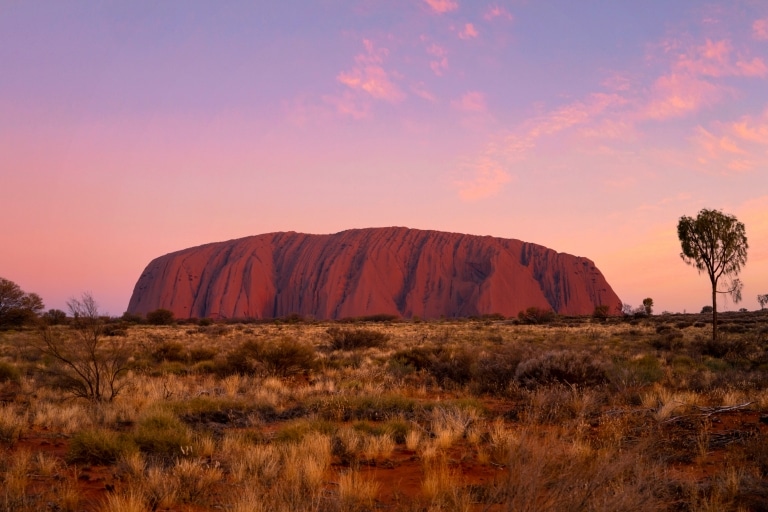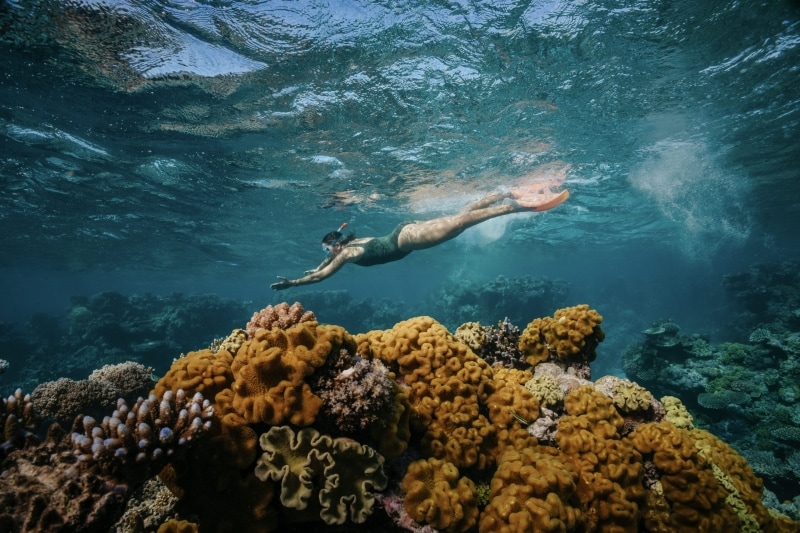
Uluru Astro Tours, Uluru, Northern Territory © Tourism NT/Tourism Australia
Uluru Astro Tours, Uluru, Northern Territory © Tourism NT/Tourism Australia
Australia’s most famous natural landmarks
Towering waterfalls, bubble-gum pink lakes and the Great Barrier Reef are just some of Australia’s famous natural landmarks waiting to be explored.
The Great Barrier Reef is the world’s largest coral reef system and home to amazingly diverse marine life. Above the water, the reef is dotted with picturesque tropical islands and some of the world’s most beautiful sun-soaked beaches. You can visit them all on an island escape or from exciting coastal gateways like Cairns and the Whitsundays.
Uluru-Kata Tjuta National Park, in the heart of the Red Centre, is home to two of the country’s most astounding rock formations – Kata Tjuta and Uluru. The sheer size of these monoliths will impress, as they emerge from an otherwise flat landscape. But it’s the spirituality and rich Aboriginal history connected to these sacred places that will leave a lasting impression.
Almost too baffling (and beautiful) to believe, Kati Thanda-Lake Eyre in South Australia is known for its beautiful pink hue, stretching across an incredible 144 km (89 mi). Most of the time, the lake is comprised of a dry, sparkling pink salt bed, but once every few years, a downpour of rain floods the region in a dazzling display. The best way to experience the pastel pink spectacle is aboard a scenic flight from the underground opal mining town of Coober Pedy during a half-day adventure with Wrightsair.
One of the highlights of the spectacular Great Ocean Road, the 12 Apostles rise defiantly from the wild Southern Ocean, creating spectacular vistas both from above and below. Soar above the remaining spires (there are just eight still standing) in a helicopter, or take the Gibson Steps down to the sand to appreciate the vertical coastal cliffs from another angle.
The crystal clear waters of Ningaloo Reef are home to the world’s largest fringing reef, a 260km (162mi) long coral reef you can access right from the beach. It’s a wildlife wonderland, famous for its abundance of turtles, tropical fish, manta rays and humpback whales. But perhaps the most famous locals are the giant-yet-gentle whale sharks, which congregate here in large numbers each winter.
Located in Blue Mountains National Park, the Three Sisters is a strikingly unusual rock formation that, according to Aboriginal legend, represents three sisters who were turned to stone. The tallest of the sisters stands at over 920m (3,000ft) above sea level, towering over the blue haze of the Jamison Valley. View them from Echo Point Lookout, or embark on one of the many bushwalks in the area for a unique perspective.
Winter in Tasmania is filled with incredible experiences, and if you’re ready to leave urban life for a wilderness escape, you may just be rewarded with the most spectacular natural light show. The Southern Lights, or Aurora Australis, is a colourful natural phenomenon that paints the night sky with flickers of blue, purple, green and red.
The four-tiered Mitchell Falls is a spectacular site, set amidst the red rocks of the Kimberley. This oasis is set in an ever-changing landscape of tropical rainforest and dramatic cliffs. While it’s perhaps best viewed from the air, consider hiking the 8.6km (5.3mi) return track to see galleries of ancient rock art paintings, wildlife and panoramic views.
Wilpena Pound, in the Flinders Ranges, is a huge, sunken natural amphitheatre – a vast crater carved out of the desert, surrounded by jagged mountains. Covering eight times the area of Uluru, this region is renowned for its geological history. Join an Aboriginal guide to explore rock art, find ancient fossils and spot wildlife throughout this spectacular landscape.
Chasms, gorges and the signature yellow and black striped domes of the Bungle Bungle Range are some of the iconic natural attractions that make the Kimberley region so geologically astounding. The Bungle Bungles themselves, caused by twenty million years of erosion, are a spectacular sight from the ground or from a scenic flight. The fact that so few people have visited this remote region makes it all the more special.
Giant boulders perched precariously on the cliffs of Flinders Chase National Park, the Remarkable Rocks are one of Kangaroo Island’s most unique natural attractions. Covered with bright orange lichen and carved away by wind erosion, the granite boulders have been shaped into sculptural masterpieces that come to life at sunrise and sunset.
Head underground at Jenolan Caves to wander the stalactite-lined maze of caverns shaped by subterranean rivers. There are 10 caves to explore, each with its own mix of chambers and formations. Don’t miss Orient Cave, often regarded as one of the world's most beautiful. While you’re here, spend some time above ground as well, exploring nearby scenic walking tracks through wildlife-rich bushland.


































































































































































































